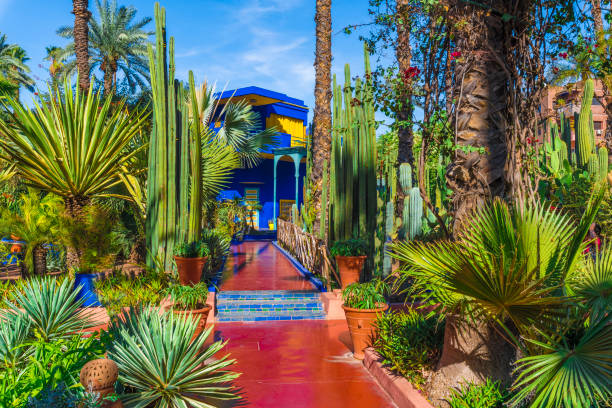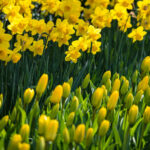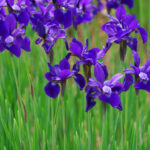Exploration of Exotic Beauty, History, and Conservation
Le Jardin Majorelle, nestled in the vibrant city of Marrakech, Morocco, is a stunning botanical garden celebrated for its tropical plants, striking design, and deep historical and cultural significance. Covering about two and a half acres, this masterpiece of landscaping draws visitors from all over the world, offering a tranquil escape from the bustling streets of the city. The tropical garden at Le Jardin Majorelle is a vivid, living tapestry of exotic plants from around the globe, set against a backdrop of bold colors, intricate architecture, and a rich artistic history.
Created by the French painter Jacques Majorelle in the early 20th century and later restored by fashion designers Yves Saint Laurent and Pierre Bergé, the garden is a unique blend of Moroccan artistry, tropical flora, and a passion for plant conservation. It stands as an oasis of calm, showcasing a wide array of tropical species while providing insight into the importance of botanical gardens as havens for biodiversity.
In this guide, we will explore the history, design, and botanical richness of the tropical garden at Le Jardin Majorelle, along with its cultural impact and enduring legacy as a model of conservation and beauty.
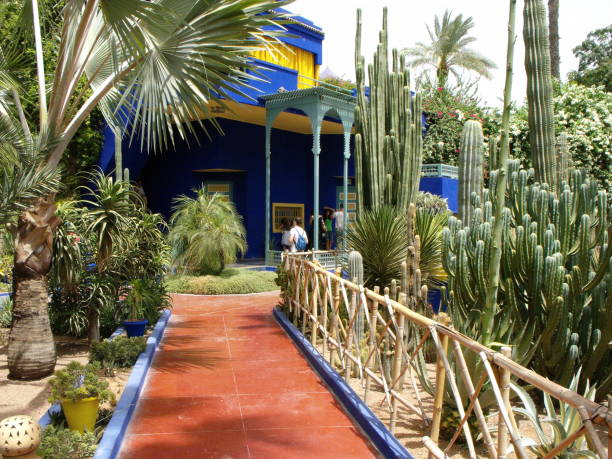
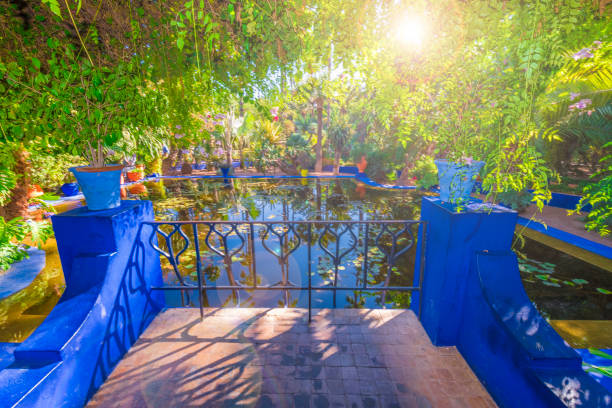
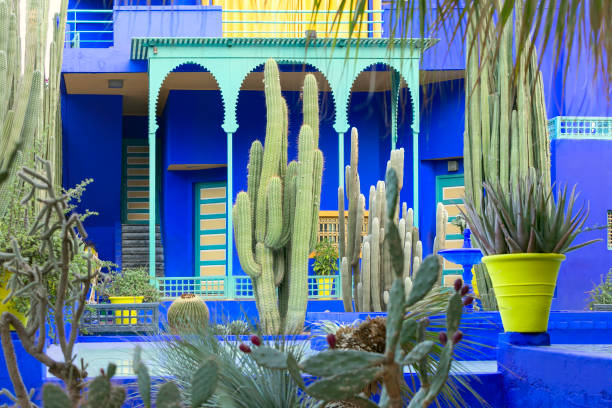
1. The Origins and History of Le Jardin Majorelle
Le Jardin Majorelle began as a labor of love for Jacques Majorelle, a French Orientalist painter who moved to Morocco in 1917. After falling in love with Marrakech’s vibrant culture and landscapes, Majorelle acquired a plot of land on the city’s outskirts in 1923. There, he embarked on creating an exotic garden inspired by his travels, particularly to tropical regions. His vision was to combine the lush, wild beauty of tropical plants with the structured elegance of Moroccan design.
Majorelle’s passion for botany was as strong as his love for painting, and over several decades, he meticulously cultivated a wide variety of tropical plants from around the world. The result was a lush, multi-layered garden that became one of the most famous in Morocco. By the 1930s, the garden had become a living canvas where Majorelle’s botanical passion and artistic sensibility converged. He painted many of the buildings in a striking shade of cobalt blue, now known as “Majorelle Blue,” a color that contrasts beautifully with the greenery and adds to the garden’s unique aesthetic.
Despite its early success, Le Jardin Majorelle fell into disrepair after Majorelle’s death in 1962. The garden, however, was saved from oblivion when fashion designers Yves Saint Laurent and Pierre Bergé purchased it in the 1980s. The couple painstakingly restored the garden to its former glory, reviving its tropical plant collection and preserving Majorelle’s artistic legacy. Today, Le Jardin Majorelle is one of the most visited sites in Morocco, attracting travelers, nature enthusiasts, and art lovers alike.
2. The Tropical Plant Collection at Le Jardin Majorelle
Le Jardin Majorelle is home to an extraordinary array of tropical and exotic plants. Despite being located in the arid environment of Marrakech, the garden thrives due to a sophisticated irrigation system that keeps the plants lush and vibrant year-round. The tropical garden’s collection reflects Jacques Majorelle’s fascination with exotic flora and his dedication to creating a diverse, multi-sensory experience for visitors.
At the heart of the tropical garden are its towering palms and cacti, which create a dramatic vertical contrast to the lower-growing plants. The garden boasts a collection of over 300 species of plants, many of which are native to tropical regions in Africa, Asia, and South America. These include species such as the towering date palm, majestic coconut trees, and the colorful bougainvillea that winds its way through the garden, offering bursts of magenta, pink, and orange blooms.
The lushness of the garden is further enhanced by the presence of bamboo groves, banana trees, and a variety of tropical ferns, which give the space an exotic and almost jungle-like atmosphere. Water features, including serene lily ponds, provide a cool respite and reflect the surrounding greenery. In the tropical garden’s ponds, water lilies and lotus flowers float serenely, adding to the tranquil, otherworldly beauty of the space.
Among the most striking features of the tropical garden are the towering yucca and agave plants, which create an almost sculptural effect with their sharp, spiky leaves. The garden is also home to a variety of succulents, which thrive in Morocco’s dry climate but originate from tropical and subtropical regions.
One of the defining characteristics of the tropical garden at Le Jardin Majorelle is the deliberate interplay of textures, colors, and heights. Majorelle’s artistic background is evident in the way the plants are arranged, with an emphasis on contrast and harmony. The lush greenery is punctuated by vibrant splashes of color, from the deep blue of the buildings to the bright red and orange flowers, creating a visually stunning landscape that feels both wild and curated.
3. The Cultural and Artistic Significance of the Garden
Le Jardin Majorelle is not only a haven of tropical plants but also a symbol of cultural fusion and artistic expression. Jacques Majorelle was deeply inspired by Moroccan art and architecture, and this is reflected in the garden’s design. The cobalt blue walls, yellow accents, and intricate Moroccan tile work create a striking backdrop for the plants, blending traditional Moroccan aesthetics with a modern, artistic sensibility.
The garden has long been a source of inspiration for artists and designers. Yves Saint Laurent, in particular, found great creative energy in the garden, and his ashes were scattered there after his death in 2008. A memorial to Saint Laurent stands within the garden, marking it as a place of personal and artistic significance for one of the 20th century’s most influential fashion designers.
In addition to its artistic heritage, Le Jardin Majorelle is a cultural hub that celebrates Morocco’s diverse influences. The garden’s museum, which is located within the grounds, houses the Berber Museum, a collection of art and artifacts that honors the indigenous Berber people of North Africa. This museum highlights the deep connection between the land, its native people, and their rich cultural traditions.
4. Botanical Conservation and Sustainability
Le Jardin Majorelle is not only a site of historical and artistic significance but also a leader in botanical conservation. The garden’s management team is committed to preserving both the native flora of Morocco and the exotic tropical species that thrive within the garden. Conservation efforts include the careful propagation of rare and endangered plants, as well as initiatives to educate the public about the importance of biodiversity and sustainable gardening practices.
In a region where water is scarce, Le Jardin Majorelle uses sustainable irrigation techniques to ensure that the garden remains lush without depleting local resources. The garden serves as a model for sustainable gardening in arid environments, demonstrating how tropical plants can thrive even in challenging climates when cared for thoughtfully and responsibly.
5. Visitor Experience and the Legacy of Le Jardin Majorelle
For visitors, Le Jardin Majorelle offers a serene and immersive experience in the heart of Marrakech. The garden’s winding pathways, shaded by tropical plants and punctuated by the sound of trickling water, provide a sense of escape from the heat and hustle of the city. It is a place where nature, art, and culture converge, offering a multi-sensory experience that delights the eyes, ears, and mind.
The legacy of Le Jardin Majorelle is one of beauty, creativity, and conservation. It stands as a testament to the vision of Jacques Majorelle, whose love for tropical plants and Moroccan culture created one of the world’s most iconic gardens. Today, under the care of the Yves Saint Laurent Foundation, Le Jardin Majorelle continues to thrive as a living museum of plant life and a sanctuary for visitors seeking peace, inspiration, and a deeper connection with nature.
Conclusion
The tropical garden at Le Jardin Majorelle is a masterpiece of botanical artistry, blending exotic plant life with Moroccan cultural heritage and modern design. It serves as a refuge for rare tropical species, a center for conservation, and a source of inspiration for generations of artists, designers, and nature lovers. Through its careful preservation and sustainable practices, Le Jardin Majorelle remains a shining example of how botanical gardens can serve as both beautiful spaces for public enjoyment and vital sanctuaries for biodiversity.

